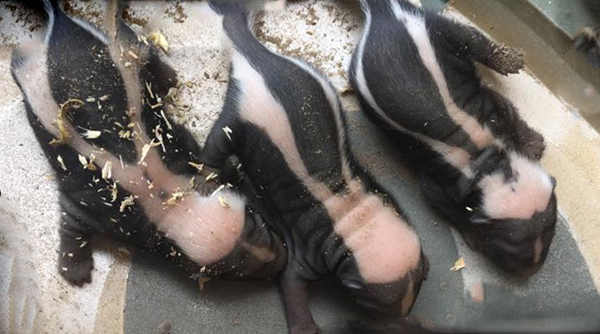- info@wildlife-removal.com
Call us for help in your town
Wildlife Removal Education
What is a skunk's mating habits?
Need skunk removal in your hometown? We service over 500 USA locations! Click here to hire us in your town and check prices - updated for year 2020.
Mating Habits
Unlike other rodents, skunks have a set of distinct and peculiar mating habits. They exhibit polygamous tendencies and do not pair. Successful male skunks mate with as many females as possible. Mating seasons vary with each species; the stripped skunks, hog-nosed skunks and hooded skunks mate between February to March while spotted skunks breed anytime from September to October.

Usually, skunks do not travel beyond two miles of their den in search of grubs to eat, but the reverse is the case during their mating season. Male skunks have been known to travel for up to five miles in search of females to mate with. They also experience delayed implantation as the fertilized egg doesn't attach to the uterine wall for a period of time after breeding.
Live Birthing
In late April and May, females of both spotted and stripped skunks do give birth to four to seven young ones. They birth them in an underground nest lined with dried grass and other vegetation. Skunks are placental and usually, their gestation period lasts for about 9 weeks. Before giving birth, the female excavates a den to house the kits.
How do skunks raise their kits?
At birth, skunk kits are usually blind, deaf and covered in a soft layer of fur. However, after about three weeks, their eyes open and subsequently, the ears too. Weaning occurs about two months after birth. After weaning, the kits generally stay with their mother until they are ready to mate. This happens when they are at about one year of age. The mother plays the most part in raising the kits. It is protective of her kits and will spray its strong and foul-smelling odor at any hint of danger or harm against the kits. Usually, male skunks play little or no role in raising the kits.
Go back to the Skunk Removal page.
Skunk nests: Skunks will live in a den like many other wild animals. They are good diggers, and they won’t hesitate to move in under a shed or a deck near your house. A skunk nest is not elaborate like a bird’s nest, though skunks will eat eggs they manage to gain access to. This is a reason why people raising chickens often notice an increase in the number of skunks coming around the property. Though not as ingenious as a fox or a weasel, a skunk will not pass up the opportunity to raid an unprotected chicken coup. The best way to keep skunks out of a poultry building is to have the perimeter enclosed with a fence. Skunks are not as determined as some predators to get inside an enclosure, but if you’re going to spend the time and energy building the barrier, you should make it fox proof as well. As for their own nests inside of their dens, skunks are relatively low-maintenance. They will not spend excessive time gathering grasses and bedding unless they are getting ready to have a litter of young.


















